Timing is everything in the garden. Figuring out when to plant vegetables in the UK really boils down to three things: what you're growing, where you live, and whether you're starting seeds indoors or sowing them straight into the garden. Get this right, and you're well on your way to a fantastic harvest. Think of it like a chef knowing exactly when to add each ingredient to a dish – the timing makes all the difference.
Your Essential UK Vegetable Planting Guide
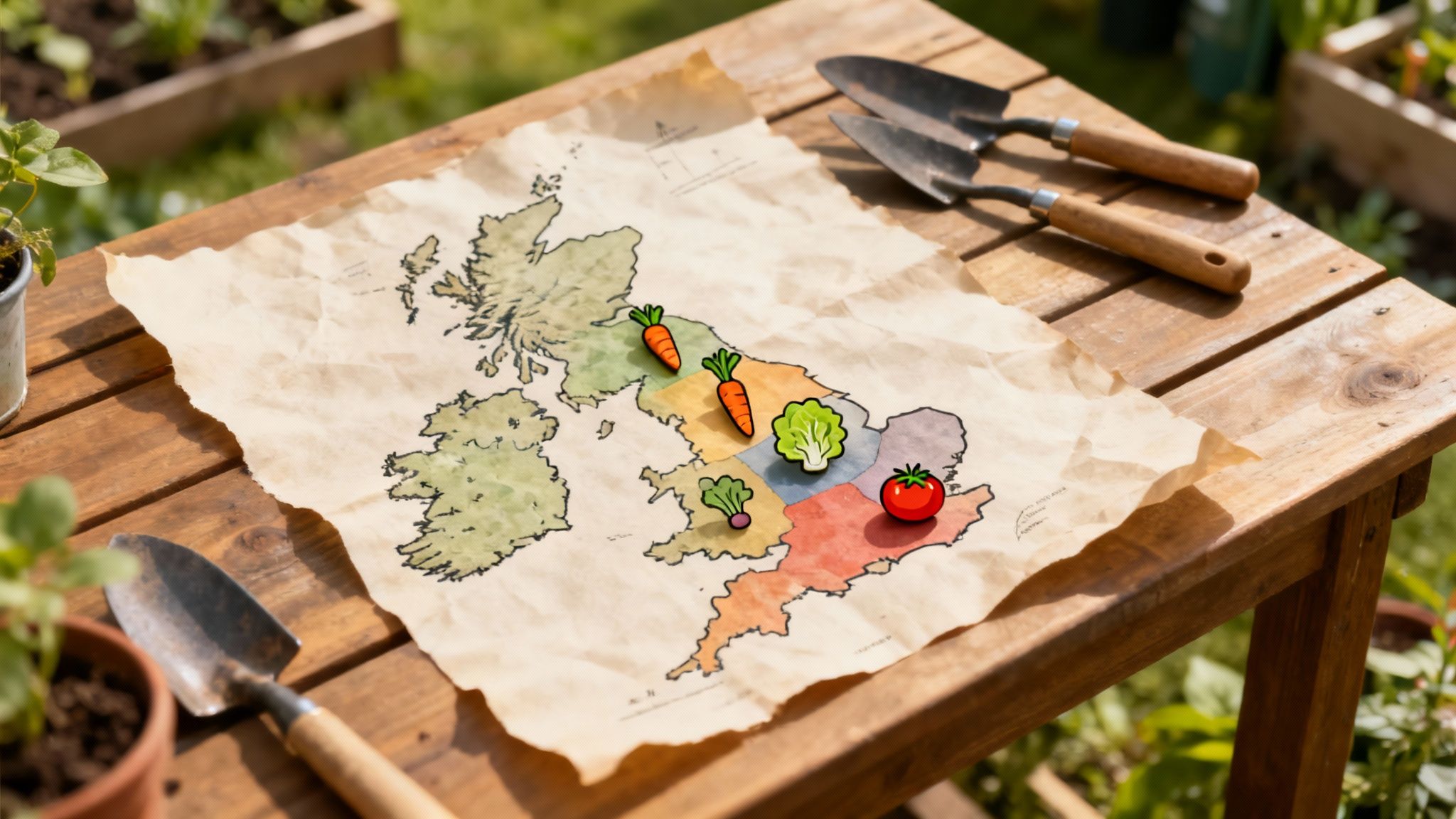
More than anything else, your success hinges on getting your seeds and plants in the ground at the opportune moment. Go too early, and a sneaky late frost could wipe out your tender seedlings overnight. Wait too long, and your crops might not have enough daylight and warmth to mature before the season turns.
Every vegetable has its own internal clock, a schedule that’s tuned to its cold tolerance and how long it needs to grow. This guide is here to help you crack that code. We’ll walk through the fundamentals so you can take general advice and apply it to the unique microclimate of your own patch, ensuring all your hard work pays off with delicious, home-grown food.
Aligning with the Natural Seasons
Here in the UK, our distinct seasons are the true conductors of the garden orchestra. While you can find staples like carrots and potatoes in the shops year-round thanks to modern farming, many homegrown veggies stick to a strict natural calendar. Asparagus spears poking through in May are a classic sign the main harvest season is kicking off, with broad beans following closely behind in June.
Getting a feel for these natural cycles is the first step in planning your plot. If you're curious about the bigger picture, you can find more on the subject in the latest UK horticulture statistics from the government.
The secret to a brilliant vegetable garden is simple: work with nature, not against it. Planting in tune with the seasons gives your crops the best possible start for germination, growth, and fruiting.
A Quick Look at Planting Times
To make things easier, let's start by grouping vegetables into a few broad categories. Each group has different needs and follows a slightly different timeline, which tells you when to get them started.
To give you a basic idea, here's a general overview to get you started on your planning:
- Hardy Vegetables: These are the tough ones. Think broad beans, onions, and some types of lettuce. They don't mind the cold, so they're often the first seeds you can sow directly outside in early spring.
- Half-Hardy Vegetables: This group needs things to warm up a bit first. Beetroot and maincrop carrots fall into this category. They need warmer soil to germinate properly, so you'll plant them a little later in spring.
- Tender Vegetables: These are the sun-lovers that can't handle a frost. Tomatoes, courgettes, and peppers must be protected from the cold. The best approach is to start them indoors on a sunny windowsill and only plant them out once you're absolutely sure the last frost has passed.
Quick Guide to UK Vegetable Planting Seasons
Here’s a simple table to give you a bird's-eye view of the planting year.
This is just a starting point, of course, but understanding these basic timings is the foundation for creating a garden that provides a steady stream of fresh food right from your own back door.
Understanding Your Garden's Unique Climate
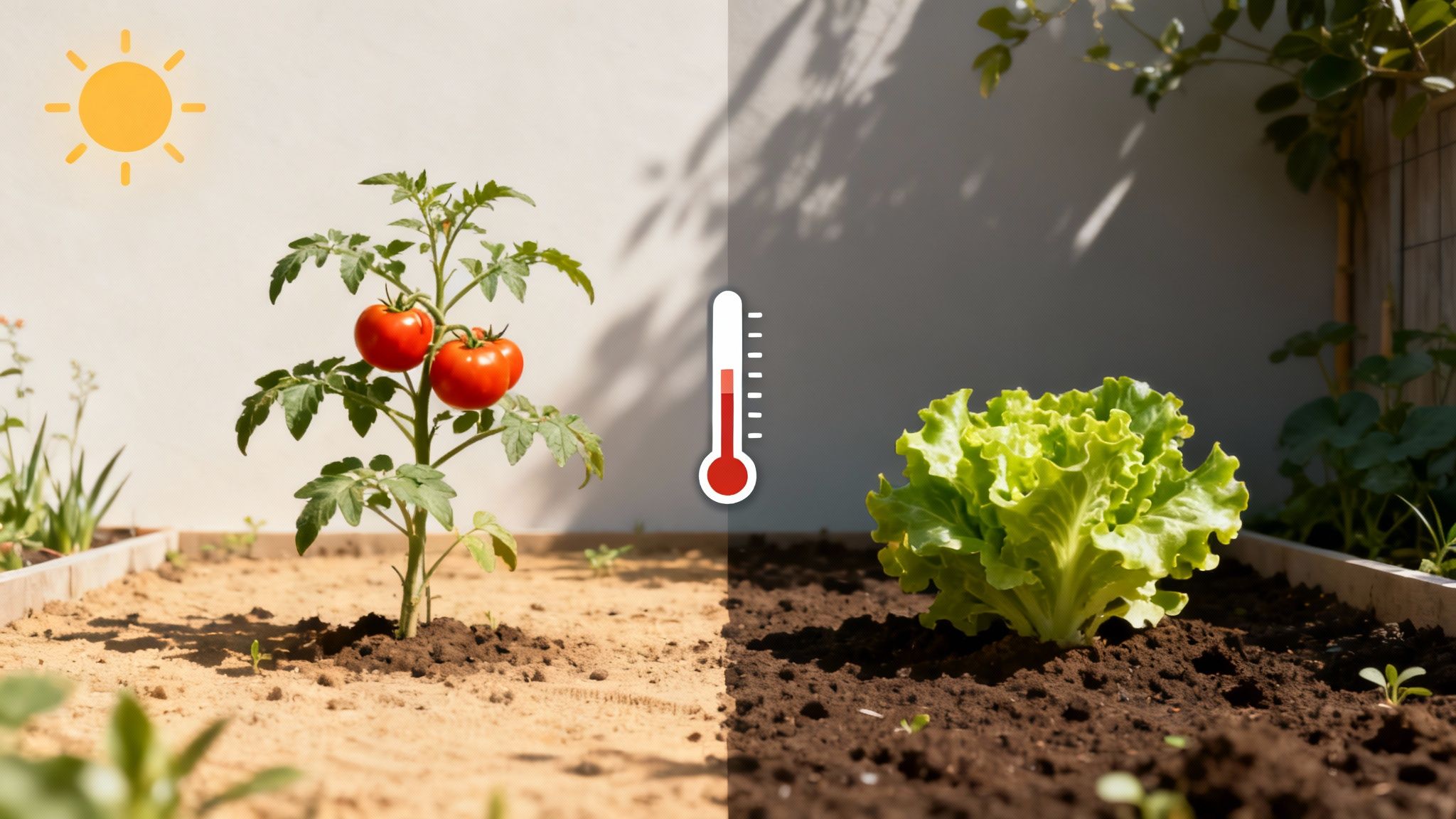
Before you even think about tearing open a seed packet, the first step is to get properly acquainted with your garden’s unique personality. Figuring out when to grow vegetables isn’t about circling a date on the calendar; it’s about reading the specific conditions of your own patch of earth. Think of your garden as having its own distinct weather system, shaped by the wider UK climate but with its own little quirks.
We all know the UK’s weather is famously unpredictable. A garden in the milder south of England will naturally have a much longer growing season than one in the chillier north of Scotland. This broad regional climate is the first piece of the puzzle. It gives you the general start and end points for your gardening year, especially the all-important last frost date in spring and the first one in autumn.
Discovering Your Garden's Microclimate
Look a little closer, and you'll find that every garden is full of microclimates. These are small pockets where the conditions are noticeably different from the surrounding area. A south-facing wall that bakes in the sun all day will be far warmer than a shady corner tucked behind the shed. That sunny spot creates the perfect home for heat-loving plants like tomatoes.
In the same way, a sheltered spot protected from the wind is a much gentler nursery for delicate seedlings than an exposed, blustery plot. Learning to spot these microclimates is like finding your garden’s hidden advantages. It lets you put the right plant in the right place, giving it the best possible shot at thriving. This is where you start to move beyond generic advice and get specific.
To get a real feel for your garden's unique conditions, you need to become an observer.
- Become a Sun-Tracker: Watch how the light moves across your garden throughout the day. Make a mental note of which areas get full sun for 6+ hours, which are in partial shade, and which are in deep shade. This is probably the single most critical factor for most veg.
- Find the Sheltered Spots: Look for areas protected from harsh winds by fences, walls, or established hedges. These spots will be warmer and much less stressful for young plants.
- Get Your Hands Dirty: How does your soil feel? Is it heavy clay that holds onto water, or is it sandy and fast-draining? The foundation of any healthy garden is good soil, and its type affects how quickly it warms up in the spring.
A microclimate is your garden’s secret weapon. A sun-trap against a brick wall can effectively create a climate zone one step warmer than your neighbour’s exposed plot, allowing you to grow crops they can’t.
The Role of Climate and Technology
Of course, the UK’s climate and modern tools play a huge part in when we can grow things. Warm-weather crops like aubergines and peppers can now be grown year-round in controlled spaces like heated greenhouses, keeping them available even in the depths of winter. On the other hand, hardy stalwarts like broccoli and cabbage are still more tied to natural seasonal timings for outdoor growing. You can dive deeper into these UK vegetable production trends with this report from the WWF.
Understanding these elements helps you make smarter choices. If you’re lucky enough to have a greenhouse, you can stretch your growing season out considerably. If not, paying close attention to your garden's natural microclimates becomes even more essential.
By taking the time to properly assess your garden's sun, shelter, and soil, you can stop guessing and start gardening with real confidence. This deep understanding of your personal growing environment is the true key to planning a productive and effective planting schedule. For a month-by-month breakdown to help with your planning, you might find our guide to the UK gardening calendar useful. This personalised approach is what turns a good vegetable patch into a great one.
Your Complete Seasonal Planting Calendar
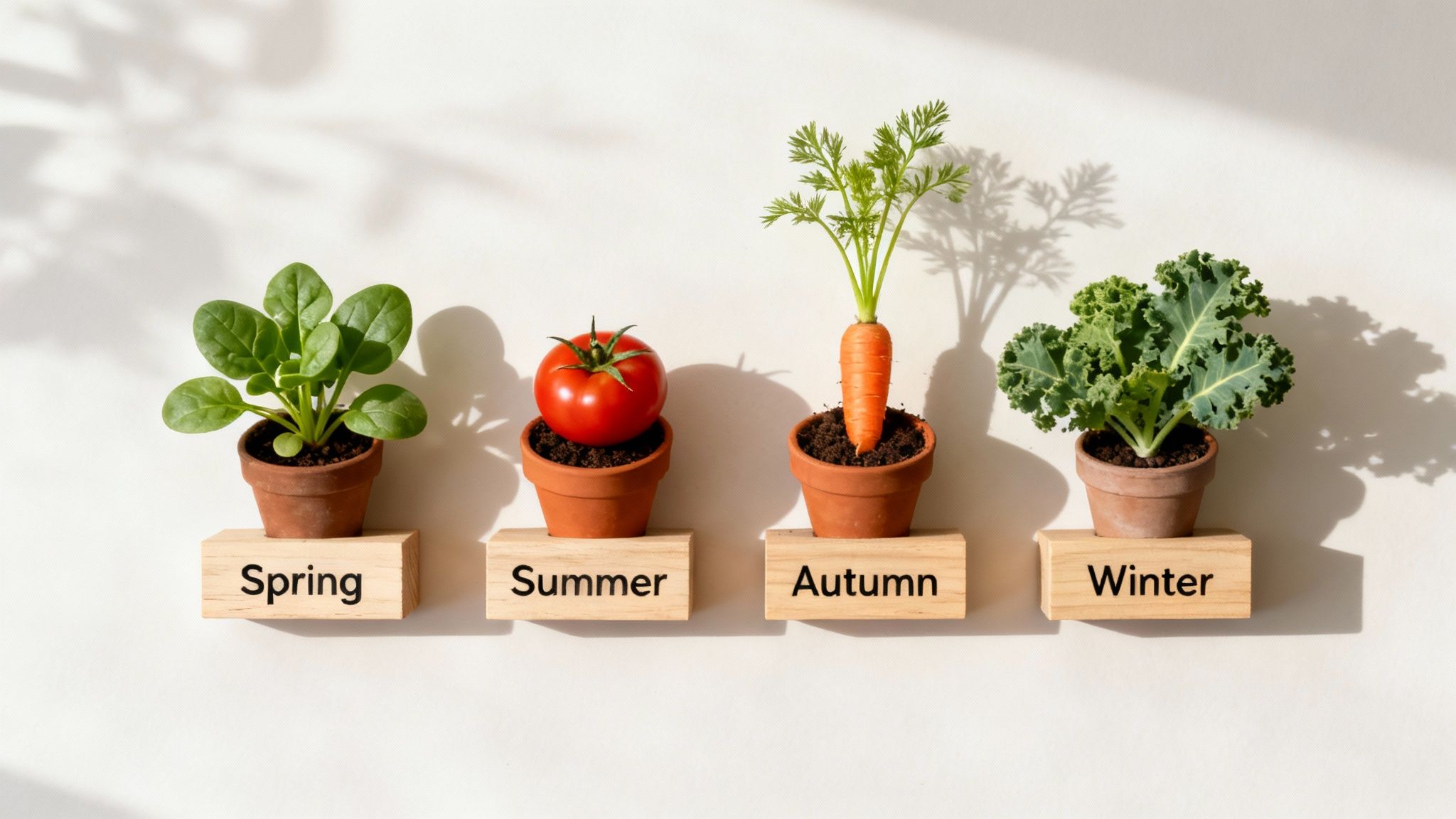
Right, let’s get our hands dirty and dive into the heart of the matter: a detailed, season-by-season guide for your vegetable plot. Knowing exactly when to grow vegetables is what turns gardening from a hopeful guessing game into a reliable source of fresh, delicious food. Think of this calendar as your gardening roadmap for the entire year, showing you what to sow, when to plant out, and how to make every inch of your garden work for you.
We'll break down the gardening year into its four distinct seasons—Spring, Summer, Autumn, and Winter. For each one, I’ll walk you through which vegetables need a gentle start indoors, which are tough enough to be sown straight into the soil, and when it's time to move your precious seedlings into their final homes. This approach keeps everything organised and helps you stay a step ahead.
The Spring Rush: Sowing and Planting
Spring is pure magic in the garden. It’s a time of explosive growth and the official kick-off to the main growing season. As the soil slowly starts to warm up and the days get longer, everything begins to wake up. But hold on—the lingering threat of frost means it's a season of two halves. We'll be starting tender plants safely inside while the hardier varieties can brave the great outdoors.
From late February through to May, your windowsills and greenhouse will transform into a bustling nursery. Tender crops like tomatoes, peppers, and cucumbers need a really long growing season and simply can't handle the cold. Giving them an indoor start is the secret to helping them thrive before they're moved outside after the last frost has passed.
At the same time, tougher vegetables can go directly into the ground as soon as the soil is workable. It’s the perfect moment for root veg and legumes that really don't like having their roots disturbed by transplanting.
To help you keep track, here's a detailed breakdown of what to plant and when.
Detailed Spring Planting Schedule for Popular Vegetables
This table should give you a solid starting point for the busiest time in the gardening year.
Spring planting is all about strategic timing. By mixing indoor and outdoor sowing, you create a continuous pipeline of plants. This ensures you’ll be harvesting at different times, really making the most of your garden's output.
Summer Sowing for a Continuous Harvest
Summer isn't just for kicking back and harvesting; it's also a crucial time for sowing to keep your veg patch productive right into the autumn and beyond. This is the season of 'succession sowing'—a simple technique of planting small batches of fast-growing crops every few weeks. Doing this guarantees you a steady supply, rather than one huge glut all at once.
Crops like lettuce, radishes, and beetroot are perfect for this and can be sown throughout the summer. You can also get a head start on your winter brassicas, like purple sprouting broccoli and winter cabbage. These will slowly mature through the colder months, rewarding you with a much-welcomed harvest when not much else is growing.
- Sow Indoors (Jun-Jul): You can start winter cabbages, purple sprouting broccoli, and calabrese indoors. This gives them a strong, healthy start before planting them out later.
- Sow Outdoors (Jun-Aug): Keep up with those succession sowings of lettuce, rocket, radishes, spring onions, and beetroot. This is also the best time to sow French beans, runner beans, and maincrop carrots directly into the soil.
- Transplant Outdoors (Jul-Aug): Plant out the winter brassicas you started indoors. Make sure they are well-watered and protect them from cabbage white butterflies with some fine netting.
For a more detailed month-by-month guide to what you should be doing, check out our complete UK planting calendar for year-round tips.
Autumn Planting for Winter and Beyond
As summer starts to fade, the garden gives us another fantastic planting window. Autumn is the perfect time to plant veg that will either overwinter for an early spring harvest or provide you with fresh greens through the coldest months. Think of it as an investment in next year’s food supply.
Hardy varieties of lettuce, spinach, and spring onions can be sown now. It’s also the traditional time to get your garlic cloves and overwintering onion sets in the ground. They’ll lie dormant during the deepest cold but will burst into life as soon as the conditions are right in spring, giving you a harvest that's weeks ahead of the spring-sown crop.
- Sow Outdoors (Sep-Nov): This is the moment for winter-hardy salad leaves like lamb's lettuce and land cress. You can also sow broad beans for an extra-early crop next year.
- Plant Outdoors (Oct-Nov): Plant your garlic cloves and overwintering onion sets. Pick a sunny, well-drained spot to stop them from rotting in wet winter soil.
Winter: The Quiet Season
For the most part, winter is a time for planning and enjoying the rewards of your autumn sowings. That said, if you have a greenhouse or cold frame, you can still sow hardy lettuces and herbs. For most UK gardeners, though, this is a period of well-earned rest for the soil.
It’s the perfect chance to put your feet up with a cup of tea, review what worked (and what didn't!), plan your crop rotation for next year, and get excited for the growing season to come.
Starting Seeds Indoors vs Sowing Directly Outside
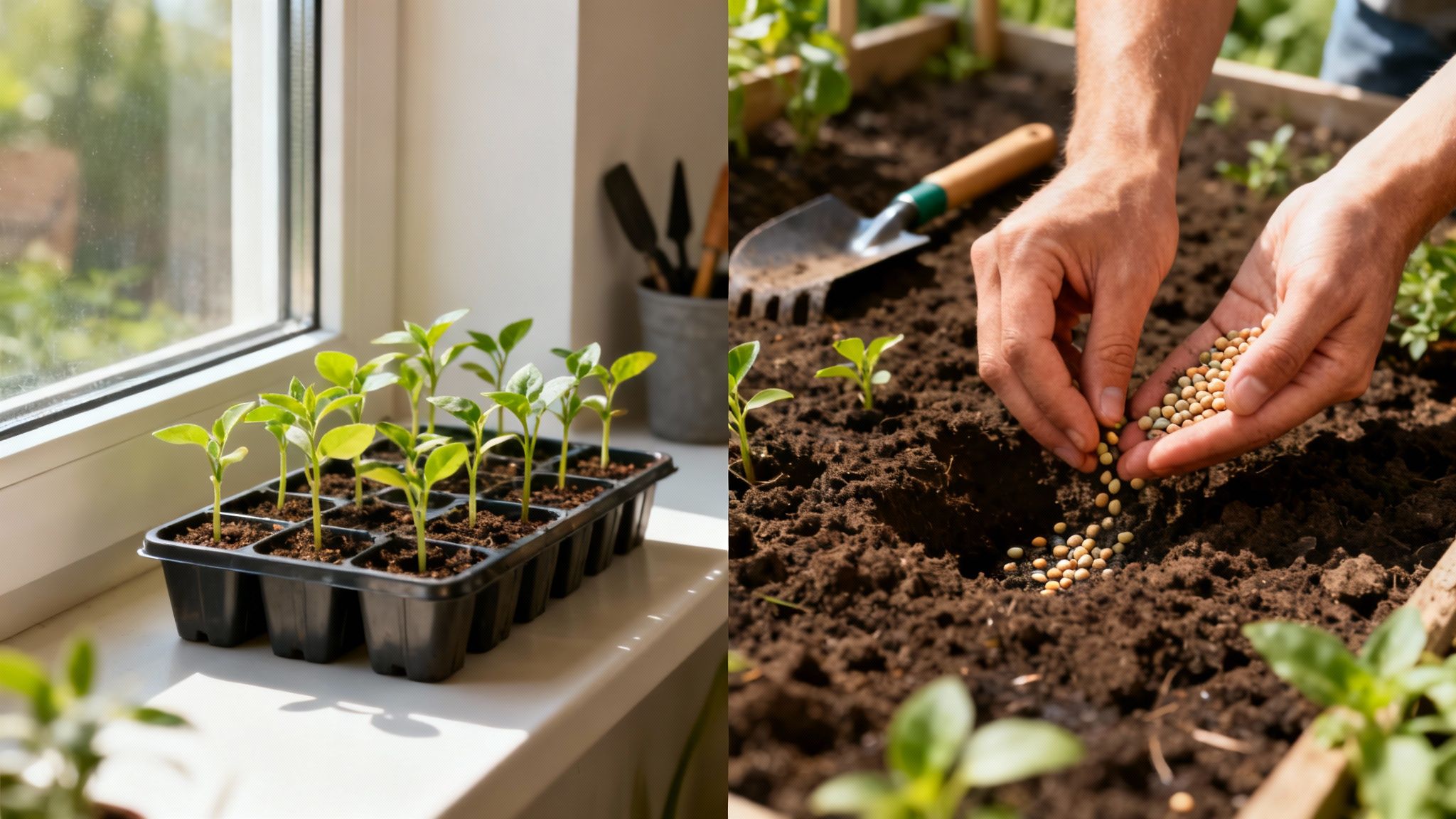
When you start flicking through a planting calendar, you'll quickly spot two main instructions: 'sow indoors' and 'sow direct'. Getting your head around these two approaches is one of the first big steps in figuring out when to grow vegetables in the often-fickle UK climate. It's a strategic decision that can be the difference between a bumper crop and a bed full of struggling plants.
Think of starting seeds inside as giving your plants a VIP pass, a head start on the season. You're creating a cosy, controlled world for them—safe from the unpredictable British weather, hungry slugs, and other garden menaces. This is absolutely vital for tender, sun-loving crops that need a long time to mature, like your tomatoes and chillies.
On the flip side, some plants just plain hate being moved. Root veg like carrots and parsnips are the prime culprits here; they need to grow straight down without any disturbance. If you try to transplant them, you risk damaging their main taproot, which is why you end up with stunted or bizarrely forked carrots. For these sturdy characters, sowing them directly where they'll grow is the only sensible option.
The Benefits of an Indoor Start
Giving certain seeds an early start on a sunny windowsill or in a greenhouse is a classic gardener's trick to stretch out the growing season. In a way, you're cheating the seasons, getting plants on the go weeks, or even months, before the ground outside is warm enough.
By the time the risk of the last frost has finally vanished, your indoor-sown seedlings aren't just seeds anymore. They're robust little plants, raring to go the second their roots hit the garden soil. This head start means you'll be harvesting far sooner than if you'd waited to sow outside.
So, who gets the indoor treatment?
- Tender Fruiting Vegetables: Tomatoes, peppers, chillies, aubergines, and cucumbers all crave a long, warm season to produce a decent crop. Starting them indoors between February and April is pretty much non-negotiable in the UK.
- Slow-Growing Brassicas: Think Brussels sprouts and big winter cabbages. They need a long time to mature, so an early start indoors ensures they're ready for your Christmas dinner.
- Tender Flowers and Herbs: Many of us also start delicate annuals and herbs like basil inside to give them the best possible shot at flourishing.
Starting seeds indoors is your ticket to growing a wider variety of crops. It allows you to cultivate vegetables that wouldn't normally have a long enough outdoor season to mature in many parts of the UK.
The Case for Sowing Directly Outside
While an indoor start is brilliant for some, many vegetables are perfectly happy—and in fact, do much better—when sown straight into the garden. It’s a simpler method that requires less faff and equipment, and it's the only way to go for plants that get stressed by having their roots disturbed. These are generally the hardier types that can handle cooler soil.
Sowing direct lets the plant grow in a more natural way. As soon as the seedling pokes through the soil, it's already adapting to the light, weather, and specific conditions of its permanent home. This often leads to a tougher, more resilient plant in the long run.
The best candidates for sowing directly are:
- Root Crops: Carrots, parsnips, radishes, and beetroot are the big ones.
- Hardy Legumes: Peas and broad beans are vigorous growers that can be sown direct from early spring.
- Salad Leaves: Quick-growing leaves like lettuce, spinach, and rocket are ideal for sowing in succession for a continuous supply.
- Some Brassicas: Fast-maturing types like turnips and kohlrabi do just fine sown direct.
Getting Started with Sowing Indoors
The whole process is wonderfully rewarding and surprisingly simple. You don’t need a high-tech setup; a bright windowsill is often more than enough to get things going. Having the right pots and trays helps, of course, especially if you're short on space. If you are trying to make the most of a patio or balcony, our guide to container gardening for beginners has some great ideas.
Before your precious seedlings can move out permanently, there’s one final, crucial step: hardening off. This is just a fancy term for getting your plants used to the great outdoors. Over a week or two, you’ll take them outside for a few hours a day, gradually increasing their time in the sun and breeze until they’re tough enough to be planted out. Whatever you do, don't skip this stage—the shock can stunt their growth or even kill them.
How to Extend Your Harvest Season
Once you've got the basics of timing down, you can start playing with the seasons a bit. This is where the real fun begins, pulling more food from your garden for much longer than you thought possible. Knowing when to grow vegetables is your starting point, but learning how to stretch that window is how you become a truly productive gardener.
It’s all about moving from simply planting things to actively managing your space for the biggest possible return. The two best tricks I've learned for this are succession planting and using a bit of protection from the elements. These simple but incredibly effective strategies will turn a garden that gives you everything in one big rush into a plot that offers a steady stream of produce, from the first hints of spring right through to winter's first hard frosts.
Create a Production Line with Succession Planting
Think of your veg patch less like a one-off project and more like a little conveyor belt. Instead of putting everything on at once and getting a massive pile-up at the end, you pop a few things on every couple of weeks. That, in a nutshell, is succession planting: sowing small batches of seeds at regular intervals.
This approach is an absolute game-changer for fast-growing crops. We’ve all been there: you sow a whole packet of lettuce seeds in March and end up with 30 lettuces in May. That’s far too many to eat before they bolt and turn bitter. By sowing just a handful of seeds every two or three weeks, you get a continuous, manageable harvest all summer long.
Succession planting is the key to avoiding the classic "glut and famine" cycle in a home garden. It turns your vegetable patch into a well-managed pantry, consistently restocked with fresh produce.
The best crops for this are the ones that mature quickly and don’t need a massive amount of space. This makes it easy to tuck a new short row in whenever a little gap opens up.
- Salad Leaves: Sow speedy growers like rocket and mixed leaves every 2-3 weeks.
- Radishes: These are unbelievably quick, often ready in just four weeks. Get a new batch in the ground every 2 weeks.
- Beetroot: For a constant supply of tender roots, sow a few seeds every 3-4 weeks from spring into mid-summer.
- Spring Onions: A small sowing every 3 weeks will keep your salads and stir-fries happy.
- Bush Beans: Keep planting a new batch every 4 weeks until early July, and you’ll be picking fresh beans well into the autumn.
Yes, it takes a little more planning, but the payoff is huge. You can't beat the feeling of having fresh food ready to pick whenever you want it.
Cheat the Seasons with Protective Structures
Another brilliant way to get more from your garden is to create little pockets of warmth and shelter, essentially tricking your plants into thinking the season is milder than it really is. Simple structures can shield your crops from the worst of the weather, giving you a head start in spring and letting you harvest much later into autumn.
These bits of kit work by creating microclimates. They raise the soil and air temperature by a few crucial degrees, and that small difference is often all it takes to get seeds to germinate in March or to save a late crop of lettuce from the first frost.
Here are a few of my go-to options:
- Cloches: These are just mini-greenhouses for individual plants or short rows. They trap the sun's warmth and are fantastic for protecting young seedlings from cold winds and hungry pests.
- Cold Frames: A cold frame is basically a bottomless box with a see-through lid. It’s perfect for hardening off seedlings you’ve grown indoors or for growing hardy salads right through the winter.
- Fleece: I always have a roll of horticultural fleece handy. It’s a lightweight fabric you can just drape over your crops. It provides a few degrees of frost protection without blocking light or rain, making it ideal for covering early potatoes or tender plants on a surprisingly cold night.
By using these, you can sow hardy crops like carrots and broad beans several weeks earlier than you could in the open garden. Come autumn, they’ll keep things like spinach and winter lettuces going for ages. For a deeper dive, our guide on protecting plants in winter has more tips to keep your garden productive.
Combine these two techniques, and you'll completely transform your garden into a space that rewards you with fresh food for most of the year.
Answering Your Top Vegetable Growing Questions
Even with the best planting calendar in hand, questions always come up. It's one thing to read a chart, but another entirely to apply it to your own patch of soil. Let's dig into some of those common head-scratchers that can make or break a harvest.
Think of this as your go-to FAQ for getting your timings just right. We'll clear up the confusion so you can get on with the fun part – planting.
What Is the Last Frost Date and Why Does It Matter So Much?
The last frost date is simply the average date of the last light freeze in your local area for the spring. It's the most important date in a vegetable gardener's calendar because it signals when it's finally safe to plant out tender crops.
Planting things like tomatoes, courgettes, or peppers before this date is a massive gamble; one cold snap can wipe them out overnight. For hardier veg like broad beans or kale, you can get a head start, but the last frost date is the real green light for the main summer growing season.
I Missed the Spring Planting Window – Is It Too Late?
Not at all! Life gets busy, and it's easy to miss that ideal spring window. But don't despair – think of it as a chance to shift your focus to a different set of crops that will be just as rewarding.
You can sow quick-growing vegetables like radishes, salad leaves, and spinach right through the summer for a fast harvest. Another great shortcut is to buy young plants from a garden centre to give yourself an instant boost. Better yet, late summer is the perfect time to sow for an autumn and winter harvest. Think kale, winter lettuces, and spring cabbages that will keep you going through the colder months.
A missed spring window isn't a failure. It's an open invitation to plan for a delicious autumn and winter harvest instead.
How Important Is Soil Temperature When Planting?
Soil temperature is every bit as important as the air temperature, especially for getting seeds to sprout. If the air is the signal to grow, the soil is the warm, cosy bed the seeds need to wake up in. Every vegetable seed has its happy place.
For example, peas are tough little things and will happily germinate in soil that's only 5°C. Sweetcorn, on the other hand, is a sun-worshipper and won't even think about sprouting until the soil hits at least 15°C. Popping seeds into soil that’s too cold is a recipe for disaster; they'll often just rot before they get a chance to grow. A simple soil thermometer is a brilliant tool, but a good rule of thumb is to wait until the soil feels workable and not cold or clammy to the touch.
What Are the Easiest Vegetables for a Beginner to Grow?
If you're just starting out, the key is to build confidence with some easy wins. Choosing reliable, low-maintenance vegetables means you're more likely to get a satisfying harvest without too much fuss, which makes the whole experience so much more enjoyable.
For the UK climate, you can't go wrong with these:
- Salad Leaves: Look for 'cut-and-come-again' types. You just snip what you need, and they keep on giving.
- Radishes: The ultimate for instant gratification. They can be ready to eat in as little as four weeks!
- Courgettes: Notoriously productive. Be warned, one or two plants is often more than enough for a family.
- Runner Beans & Peas: These are brilliant for small spaces as they grow upwards, taking up very little ground.
- Potatoes: A real British staple and surprisingly easy to grow. We've got a whole guide on how to grow potatoes to get you started.

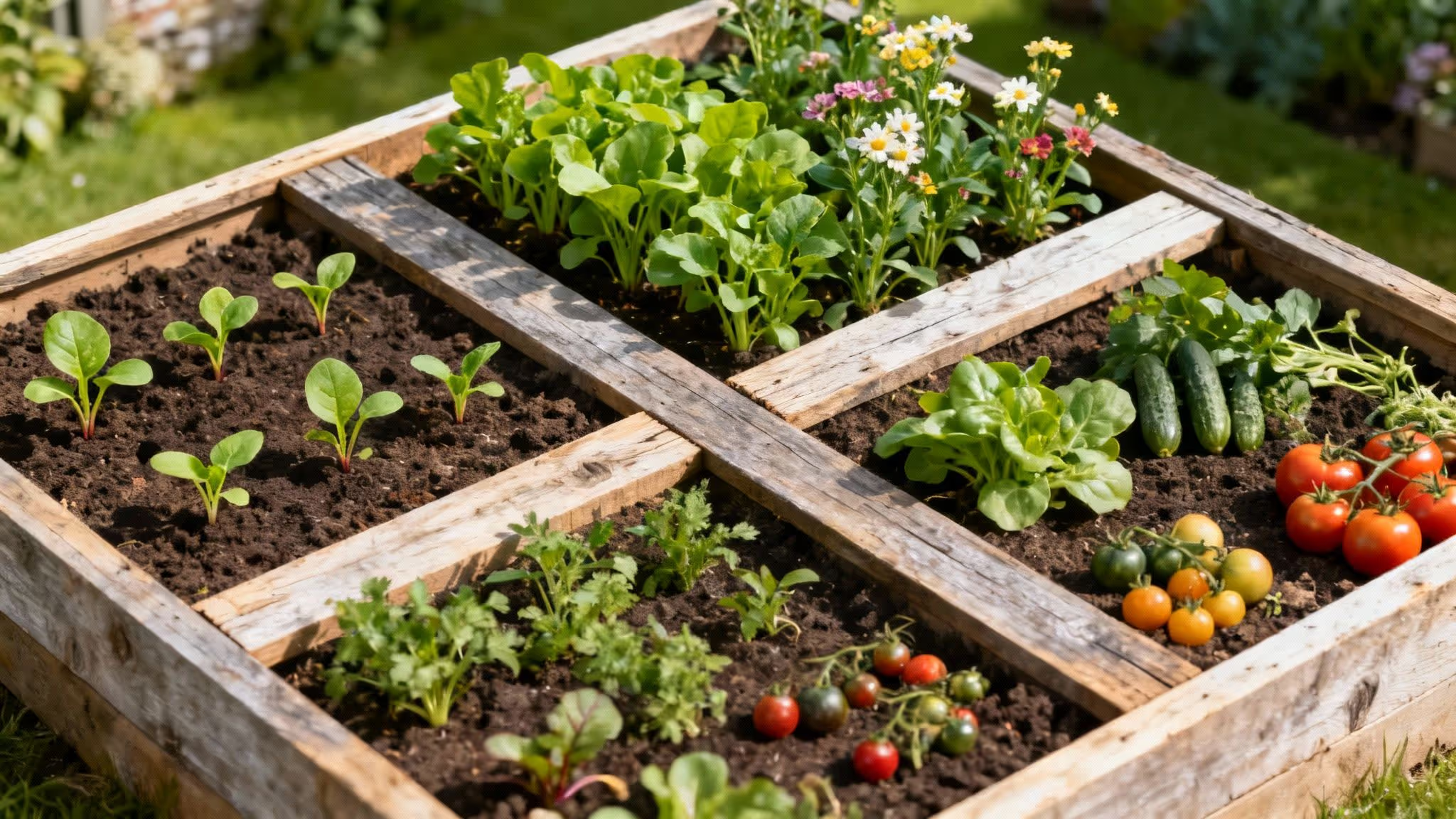
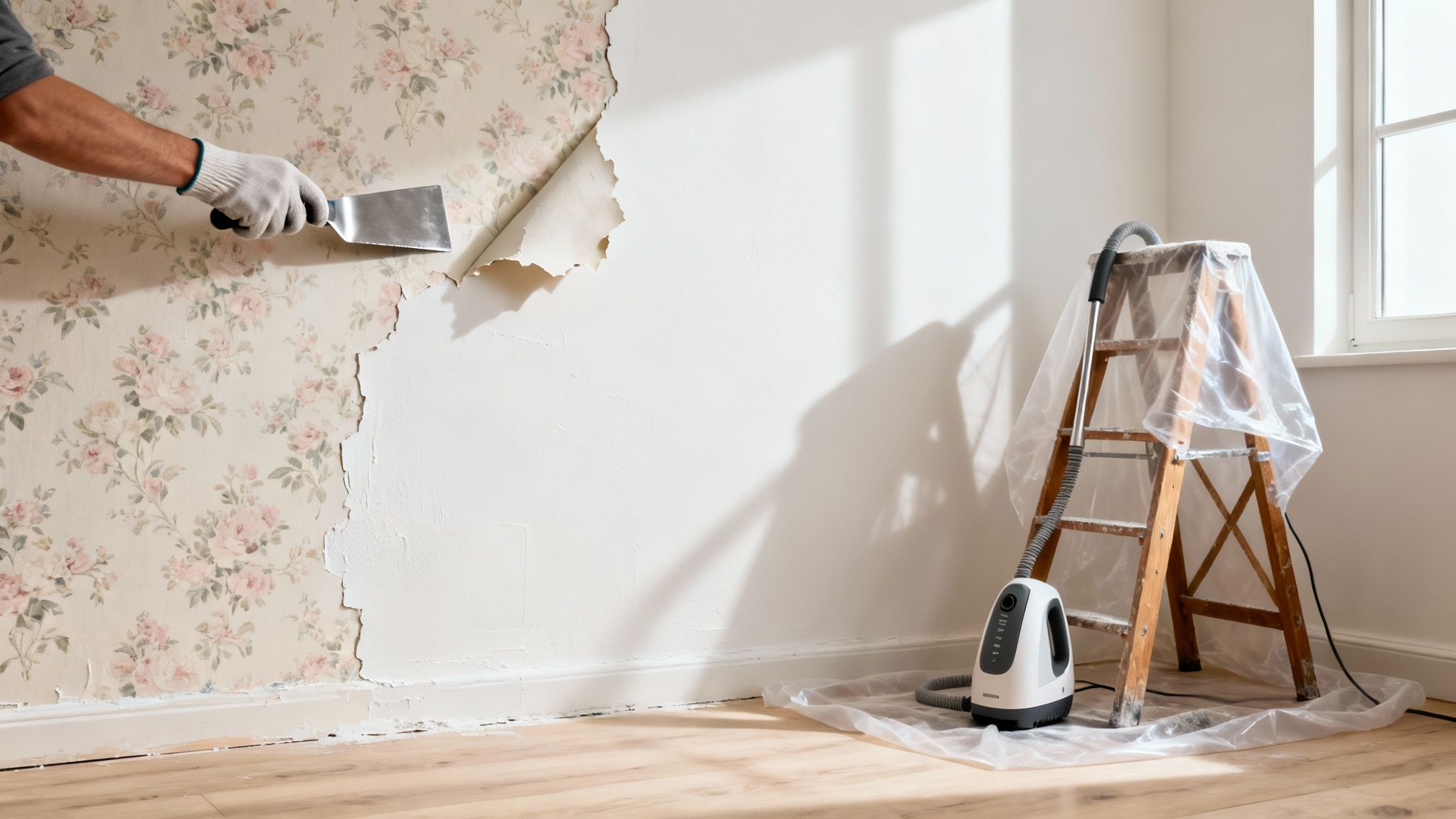

.jpeg)